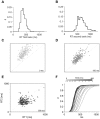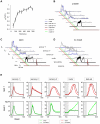The brain's router: a cortical network model of serial processing in the primate brain
- PMID: 20442869
- PMCID: PMC2861701
- DOI: 10.1371/journal.pcbi.1000765
The brain's router: a cortical network model of serial processing in the primate brain
Abstract
The human brain efficiently solves certain operations such as object recognition and categorization through a massively parallel network of dedicated processors. However, human cognition also relies on the ability to perform an arbitrarily large set of tasks by flexibly recombining different processors into a novel chain. This flexibility comes at the cost of a severe slowing down and a seriality of operations (100-500 ms per step). A limit on parallel processing is demonstrated in experimental setups such as the psychological refractory period (PRP) and the attentional blink (AB) in which the processing of an element either significantly delays (PRP) or impedes conscious access (AB) of a second, rapidly presented element. Here we present a spiking-neuron implementation of a cognitive architecture where a large number of local parallel processors assemble together to produce goal-driven behavior. The precise mapping of incoming sensory stimuli onto motor representations relies on a "router" network capable of flexibly interconnecting processors and rapidly changing its configuration from one task to another. Simulations show that, when presented with dual-task stimuli, the network exhibits parallel processing at peripheral sensory levels, a memory buffer capable of keeping the result of sensory processing on hold, and a slow serial performance at the router stage, resulting in a performance bottleneck. The network captures the detailed dynamics of human behavior during dual-task-performance, including both mean RTs and RT distributions, and establishes concrete predictions on neuronal dynamics during dual-task experiments in humans and non-human primates.
Conflict of interest statement
The authors have declared that no competing interests exist.
Figures







Similar articles
-
A shared cortical bottleneck underlying Attentional Blink and Psychological Refractory Period.Neuroimage. 2012 Feb 1;59(3):2883-98. doi: 10.1016/j.neuroimage.2011.09.063. Epub 2011 Oct 1. Neuroimage. 2012. PMID: 21988891
-
Overlapping attentional networks yield divergent behavioral predictions across tasks: Neuromarkers for diffuse and focused attention?Neuroimage. 2020 Apr 1;209:116535. doi: 10.1016/j.neuroimage.2020.116535. Epub 2020 Jan 12. Neuroimage. 2020. PMID: 31940476
-
Probing the cortical network underlying the psychological refractory period: a combined EEG-fMRI study.Neuroimage. 2011 Jun 1;56(3):1608-21. doi: 10.1016/j.neuroimage.2011.03.017. Epub 2011 Mar 21. Neuroimage. 2011. PMID: 21397701
-
Reward-dependent learning in neuronal networks for planning and decision making.Prog Brain Res. 2000;126:217-29. doi: 10.1016/S0079-6123(00)26016-0. Prog Brain Res. 2000. PMID: 11105649 Review.
-
How the brain blinks: towards a neurocognitive model of the attentional blink.Psychol Res. 2006 Nov;70(6):425-35. doi: 10.1007/s00426-005-0009-3. Epub 2005 Oct 20. Psychol Res. 2006. PMID: 16237554 Review.
Cited by
-
Neural Mechanisms That Make Perceptual Decisions Flexible.Annu Rev Physiol. 2023 Feb 10;85:191-215. doi: 10.1146/annurev-physiol-031722-024731. Epub 2022 Nov 7. Annu Rev Physiol. 2023. PMID: 36343603 Free PMC article. Review.
-
Neural dynamics and circuit mechanisms of decision-making.Curr Opin Neurobiol. 2012 Dec;22(6):1039-46. doi: 10.1016/j.conb.2012.08.006. Epub 2012 Sep 28. Curr Opin Neurobiol. 2012. PMID: 23026743 Free PMC article. Review.
-
Cognitive programs: software for attention's executive.Front Psychol. 2014 Nov 25;5:1260. doi: 10.3389/fpsyg.2014.01260. eCollection 2014. Front Psychol. 2014. PMID: 25505430 Free PMC article.
-
Strategic and Non-Strategic Semantic Expectations Hierarchically Modulate Neural Processing.eNeuro. 2020 Oct 19;7(5):ENEURO.0229-20.2020. doi: 10.1523/ENEURO.0229-20.2020. Print 2020 Sep/Oct. eNeuro. 2020. PMID: 33023884 Free PMC article.
-
Emergence in the central nervous system.Cogn Neurodyn. 2013 Jun;7(3):173-95. doi: 10.1007/s11571-012-9229-6. Epub 2012 Nov 28. Cogn Neurodyn. 2013. PMID: 24427200 Free PMC article.
References
-
- Roelfsema PR, Lamme VA, Spekreijse H. The implementation of visual routines. Vision Res. 2000;40:1385–1411. - PubMed
-
- Ullman S. Visual routines. Cognition. 1984;18:97–159. - PubMed
-
- Anderson JR, Lebiere C. The atomic components of thought. Mahwah, NJ: Lawrence Erlbaum Associates; 1998.
-
- Pashler H. Processing stages in overlapping tasks: evidence for a central bottleneck. J Exp Psychol Hum Percept Perform. 1984;10:358–377. - PubMed
-
- Raymond JE, Shapiro KL, Arnell KM. Temporary suppression of visual processing in an RSVP task: an attentional blink? J Exp Psychol Hum Percept Perform. 1992;18:849–860. - PubMed
Publication types
MeSH terms
LinkOut - more resources
Full Text Sources
Research Materials

